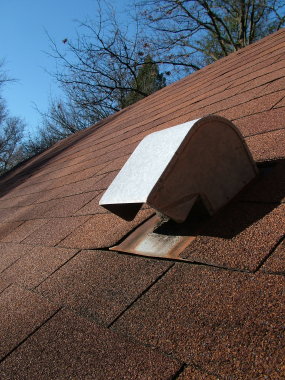Related Articles: Ducted Bathroom Fan, Bathroom Exhaust Fan Leaks Cold Air, Bathroom Exhaust Fans, Bathroom Exhaust Fans Video
DEAR TIM: I'm remodeling a second floor master bathroom and will be installing a new ceiling-mounted ventilation fan. The fan itself will only be three feet from an exterior wall so I could easily extend an exhaust pipe through the attic and have it terminate at the soffit overhang. Do you see any problems with this method? I can extend the exhaust pipe towards a roof ventilation hole but I am worried that water might condense and run backwards towards the fan. What would you do? Larry L., Bloomfield Hills, MI
DEAR LARRY: I can only think of one other method that might cause more damage and destruction than the two methods you have proposed. Some builders, subcontractors and unknowing do-it-yourselfers simply let bathroom exhaust fans blow air directly into the attic space. Talk with any seasoned certified home inspector and she / he may tell you tales of horrible attic mold and wood rot in the roof framing and roof sheathing.

When this moist air gets into the attic, it will readily condense into liquid water on the cool or cold attic framing surfaces. This liquid water is the needed spark to ignite active mold growth and fungi growth that causes wood rot. The actual buildup of water on these surfaces can turn to a thick layer of frost in very cold weather. I have seen it and it is a very eery feeling.

I have found that it is often best to vent fans and dryers through the roof. I urge you to watch this video of mine to see how easy it is to install the correct vent-cap flashing on a roof. Have no fear - if done right you will have no leaks.
This same problem can happen if you extend a bathroom exhaust fan and terminate it at or near a rooftop ventilation hole. Some of the air may make it outdoors, but some will undoubtedly find its way to other places in the attic. The best way is to simply extend the pipe through the roof and end it with a special bathroom exhaust fan termination cap that includes a damper.
I prefer to use smooth galvanized steel pipe to duct the air from the fan to the outdoors. Your concern about condensation forming inside the pipe is valid. It can and does happen to thousands of people because the installer failed to insulate the pipe. For this task, I prefer to use spray foam that comes in an aerosol can. Clean the exterior of the pipe with a rag soaked in mineral spirits to remove the residual oil film from the manufacturing process. The pipe should be covered with at least 1.5 inches of dried cured foam, and you must cover all of the exposed metal pipe from the fan all the way to the exhaust termination cap at the underside of the roof.

Don't try to wrap the pipe with standard fiberglass insulation attached with duct tape. High attic temperatures can cause many traditional duct tapes to deteriorate in attics. If you want to wrap the pipe, use special duct insulation and tape that can be purchased at heating and cooling supply businesses.
If you do not feel confident installing the exhaust fan termination cap in the roof, hire a roofer to do this. It is really not that hard, but it is a job that must be done correctly to ensure you have no leaks from rain or snowmelt.
Never underestimate the amount of damage simple water vapor can do. This danger is real for all homeowners, even those who live in very dry climates. Those who live in warm humid climates are at grave risk for rapid mold growth and wood rot. Don't think for a moment that you are immune from damage because of where you live.
It is also very important to install the exhaust piping as directed by the fan manufacturer. Short runs are better and you can only insert in the line a given amount of bends in the piping. The pipe and bends create friction to the moving air. If you install too much pipe or too many bends, the fan motor simply will not be able to push the air to the exterior of your home.